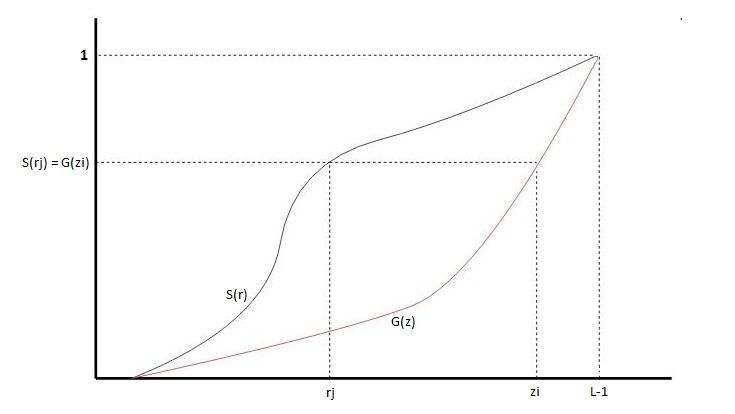Histogram Specification on:
[Wikipedia]
[Google]
[Amazon]
 In
In
 Each pdf (probability density function) can easily be mapped to its cumulative distribution function by
:
:
Where L is the total number of gray level (256 for a standard image).
The idea is to map each r value in X to the z value that has the same probability in the desired
Each pdf (probability density function) can easily be mapped to its cumulative distribution function by
:
:
Where L is the total number of gray level (256 for a standard image).
The idea is to map each r value in X to the z value that has the same probability in the desired
 It will be matched to this reference histogram to emphasize the lower gray levels.
It will be matched to this reference histogram to emphasize the lower gray levels.
 After matching, the output image has the following histogram
After matching, the output image has the following histogram And looks like this
And looks like this
image processing
An image or picture is a visual representation. An image can be two-dimensional, such as a drawing, painting, or photograph, or three-dimensional, such as a carving or sculpture. Images may be displayed through other media, including a pr ...
, histogram matching or histogram specification is the transformation of an image so that its histogram
A histogram is a visual representation of the frequency distribution, distribution of quantitative data. To construct a histogram, the first step is to Data binning, "bin" (or "bucket") the range of values— divide the entire range of values in ...
matches a specified histogram. The well-known histogram equalization
Histogram equalization is a method in image processing of contrast adjustment using the image's histogram.
Histogram equalization is a specific case of the more general class of histogram remapping methods. These methods seek to adjust the ...
method is a special case in which the specified histogram is uniformly distributed.
It is possible to use histogram matching to balance detector responses as a relative detector calibration technique. It can be used to normalize two images, when the images were acquired at the same local illumination (such as shadows) over the same location, but by different sensors, atmospheric conditions or global illumination.
Implementation
Consider agrayscale
In digital photography, computer-generated imagery, and colorimetry, a greyscale (more common in Commonwealth English) or grayscale (more common in American English) image is one in which the value of each pixel is a single sample (signal), s ...
input image X. It has a probability density function pr(r), where r is a grayscale value, and pr(r) is the probability of that value. This probability can easily be computed from the histogram of the image by
Where nj is the frequency of the grayscale value rj, and n is the total number of pixels in the image.
Now consider a desired output probability density function pz(z). A transformation of pr(r) is needed to convert it to pz(z).
 Each pdf (probability density function) can easily be mapped to its cumulative distribution function by
:
:
Where L is the total number of gray level (256 for a standard image).
The idea is to map each r value in X to the z value that has the same probability in the desired
Each pdf (probability density function) can easily be mapped to its cumulative distribution function by
:
:
Where L is the total number of gray level (256 for a standard image).
The idea is to map each r value in X to the z value that has the same probability in the desired pdf
Portable document format (PDF), standardized as ISO 32000, is a file format developed by Adobe Inc., Adobe in 1992 to present documents, including text formatting and images, in a manner independent of application software, computer hardware, ...
. I.e. ''S''(''r''''j'') = ''G''(''z''''i'') or ''z'' = ''G''−1(''S''(''r'')).
Example
The following input grayscale image is to be changed to match the reference histogram. The input image has the following histogram It will be matched to this reference histogram to emphasize the lower gray levels.
It will be matched to this reference histogram to emphasize the lower gray levels.
 After matching, the output image has the following histogram
After matching, the output image has the following histogram And looks like this
And looks like this
Algorithm
Given two images, the reference and the target images, we compute their histograms. Following, we calculate thecumulative distribution function
In probability theory and statistics, the cumulative distribution function (CDF) of a real-valued random variable X, or just distribution function of X, evaluated at x, is the probability that X will take a value less than or equal to x.
Ever ...
s of the two images' histograms – for the reference image and for the target image. Then for each gray level